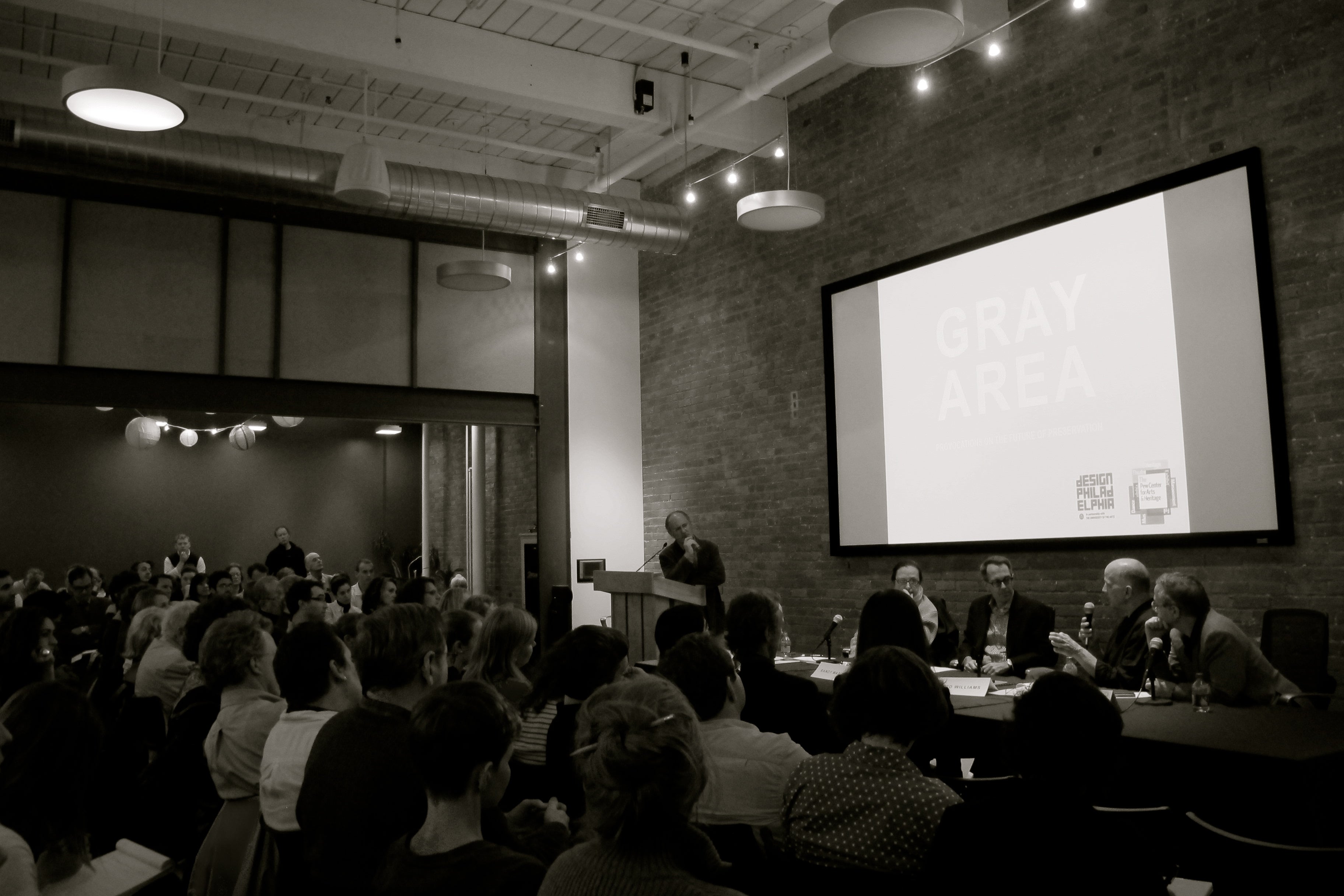Red threads through Gray Area

Last week, DesignPhiladelphia brought together design thinkers and practitioners for a discussion called “Gray Area: Provocations on the Future of Preservation.” The event, and the accompanying catalog, was designed to get people talking about historic preservation’s big questions: What is worth preserving and for whom? How can preservation be a catalyst? As the title suggests, the answer to those questions is a constant negotiation, interpreting a gray area.
At the table were Randy Mason (PennDesign’s Graduate Program in Historic Preservation – disclosure: I’m a former student of Mason’s), Lloyd Alter (editor of TreeHugger; architect/developer), Susan Szenasy (editor in chief of design magazine Metropolis), and Tod Williams (Tod Williams Billie Tsien Architects). Mark Alan Hughes, Philadelphia’s first Director of Sustainability and PennDesign Distinguished Senior Fellow in Architecture, moderated the discussion.
As promised, the Gray Area event was about provocation, not tidy answers, to complicated questions about the built environment. The catalog produced to accompany the event illuminates the conversation brilliantly (in grayscale, of course) by showcasing provocative preservation projects, both real and conceptual, from Urban Outfitters’ reuse of historic buildings at the Navy Yard to a radical reinterpretation of 30th Street Station as a 22nd-century transportation hub. Thankfully the catalog will be posted online soon, because it is a must-read.
The wide-ranging conversation covered well-trod ground (bureaucratic preservation process; preservation as urban tool to fight suburban sprawl), but also edged toward some provocative ideas about what historic preservation is, is not, and should be.
Here are my 10 takeaways, a Gray Area Manifesto of sorts:
1. Preservation is about the future. Preservation is more than some silk-scarf wearing blue-hairs trying to “Save the Clocktower.” That was yesterday. Preservation is, as Susan Szenasy said, about “who we are going to be in the 21stCentury as a culture.” As we collectively choose that future, we should carry forward the lessons that historic places teach us and use them as a foundation upon which to build a sustainable future.
2. Preservation is about Living Cities. Age is part of the variety that helps create a rich urban environment. It’s the “layering of expression,” Szenasy suggests, that helps add texture and dimension to life in an aging city.
3. Preservation does not mean “no.” Governments can restrict changes to historic buildings through local legislation, but that doesn’t mean that preservation is about stopping progress or development. Good preservation cannot and does not end with putting something under glass and then regulating the hell out of it. Instead, Tod Williams suggested, preservation’s restraints and constraints can be “the basis for our creative acts.”
4. Preservation is a tool for urban sustainability, not an impediment. Lloyd Alter brought up an academic argument that falsely pits preservation against environmentalists: Some people believe the preservation of old, lower-rise buildings in urban places prevents cities from adding density in order to accommodate the worlds growing, urbanizing population. To Randy Mason, that density argument is “a complete red herring.” And, as Szenasy pointed out, the adaptive, creative reuse of old buildings capitalizes on their “embodied energy.” Old buildings should be seen as resources to be reused not wasted. Even difficult, industrial buildings can find new purpose, as in the concept for the Granary reuse by Interface Studios shown in the Gray Area catalog. It’s time to get more comfortable with treating preservation as one among many creative design tools for shaping the future.
5. “New ideas need old buildings,” Lloyd Alter reminded the crowd, paraphrasing Jane Jacobs’ adage. Preserving older, sometimes otherwise unremarkable, buildings provides low-cost space for young innovators and artists. To Alter, these everyday, working buildings that have been lived-in and changed can be the toughest to preserve, but are important from an economic development perspective.
6. Ideally, “We’re saving [buildings] because they work,” said Alter. He thinks the buildings we preserve should be lovable, durable, flexible, and frugal. Lovability may be debatable, but the other three are critical values of old buildings that enable new incarnations.
7. “Real architects” aren’t afraid of real preservation. Architecture and preservation are not at odds, despite what some people seem to think.In defense of “real” architects like himself, Williams noted half of his firm’s work is renovation, and they’re often finding ways to insert contemporary architecture into historic places. Witness Williams’ work at Skirkanich Hall at Penn, a contemporary design creatively worked into Penn’s historic engineering quad. It’s entirely new, and works beautifully.
8. Share the burden. Tod Williams offered an idea that comes from cities in Spain: Designers are assigned a particular piece of a city to know and look after. By acting as watchful guardians of special places, the design community becomes more active in caring for their city’s heritage. It’s too much for an advocacy group or an underfunded government to do alone, so instead what would happen if we shared the burden? What could that look like in Philly?
9. Preservation is increasingly inclusive. Concerns about social justice, equity, race, and class are informing decisions about the kinds of historic sites being created and the way history is being interpreted. As a local example, Mason pointed up Germantown Avenue to Clivden, a site that’s being reinterpreted around issues of race and class.
10. “Build the community you already have,” Szenasy said. It’s up to the design community to continue having real conversations about managing urban change. Places matter to people, so the conversation should meaningfully engage the general public in design issues as well. To Szenasy, if Philadelphia, with its rich built heritage and intellectual capital, can’t create strong public discourse on preservation, then no city can.
Gray Area was supported by the Pew Center for Arts & Heritage’s Heritage Philadelphia program. A pdf of the Gray Area catalog and a video from the event will be posted on Pew’s Heritage Philadelphia program website soon.
WHYY is your source for fact-based, in-depth journalism and information. As a nonprofit organization, we rely on financial support from readers like you. Please give today.





